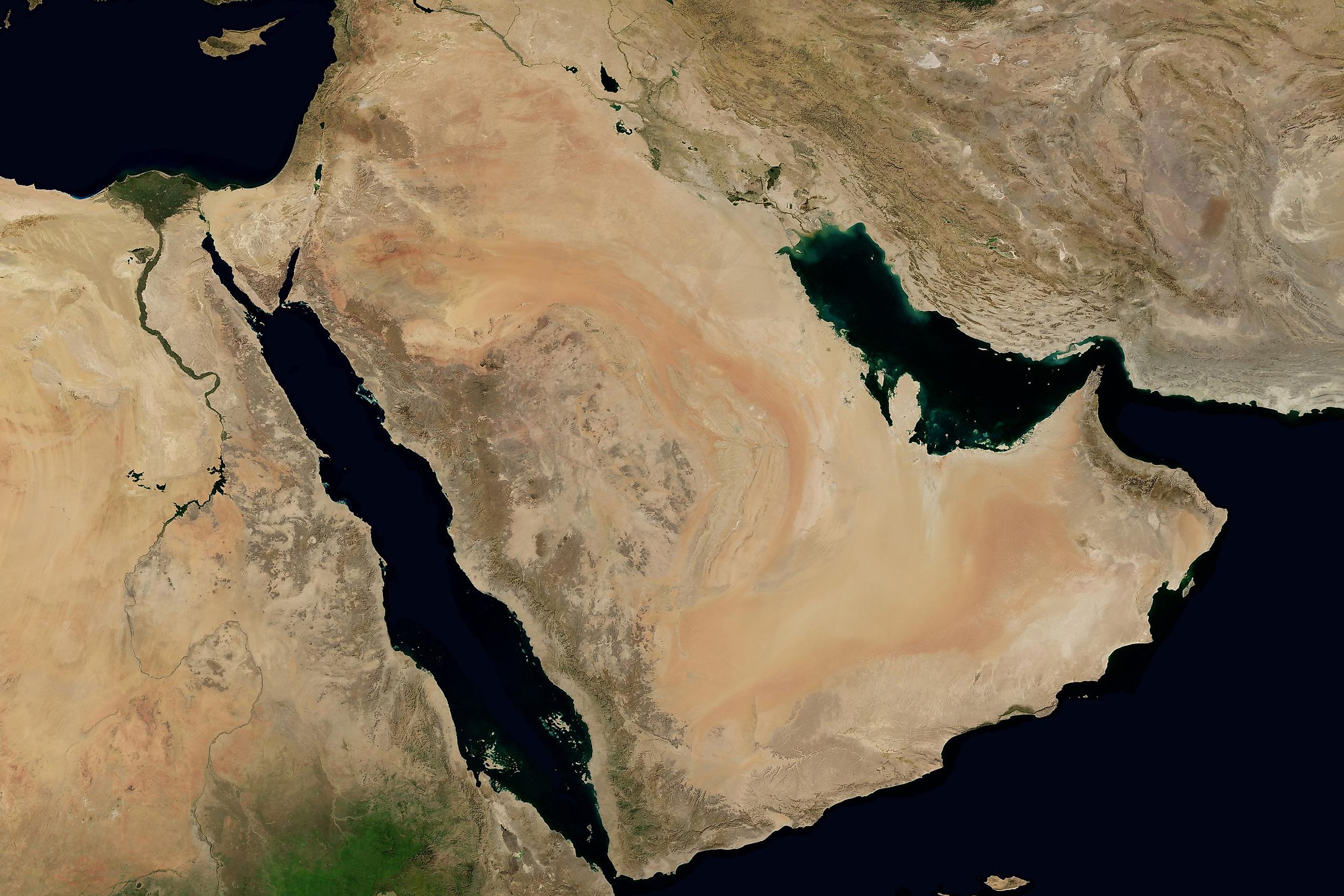
Arabian Peninsula
The Arabian Peninsula is the world’s largest peninsula by area, covering 3.2 million square kilometers. It was formed between 56 and 23 million years ago, following the rifting of the Red Sea. Geographically, the peninsula can be referred to as Arabian Subcontinent since it lies on its tectonic plate, known as the Arabian plate.
The Arabian plate is moving gradually away from Africa (creating the Red Sea) toward the Eurasia plate (forming the Zagros Mountain). The peninsula’s most prominent feature is a desert. However, mountain ranges dot the southwestern portion, which tends to be cooler and wetter than the rest of the peninsula.
Where Is The Arabian Peninsula?
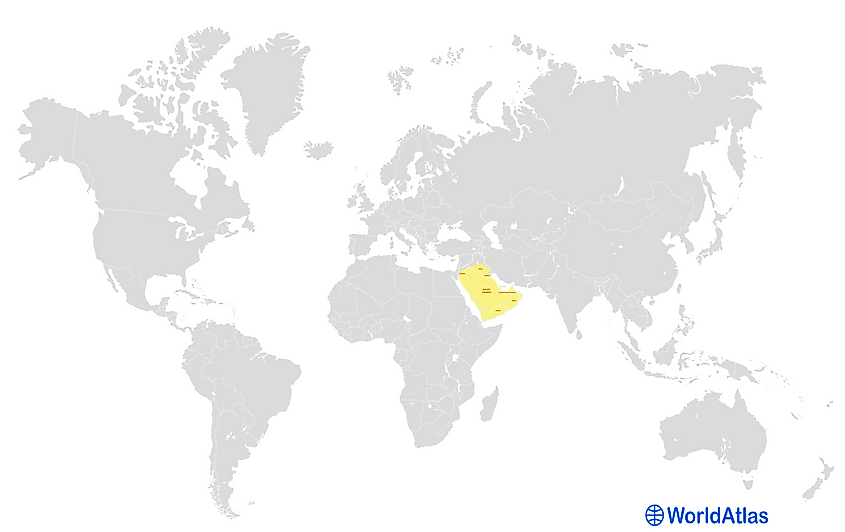
The Arabian Peninsula is located in Western Asia. It is bordered to the southwest and west by the Red Sea, northeast by the Persian Gulf, east by the Gulf of Oman and Strait of Hormuz, and southwest by the Arabian Sea. It is also bordered by the Somali Sea, Guardafui Channel, and Gulf of Eden to the south. The peninsula is located northeast of the Africa continent and separated from the continent by the Beb-el-Mandeb Strait.
Arabian Peninsula Countries
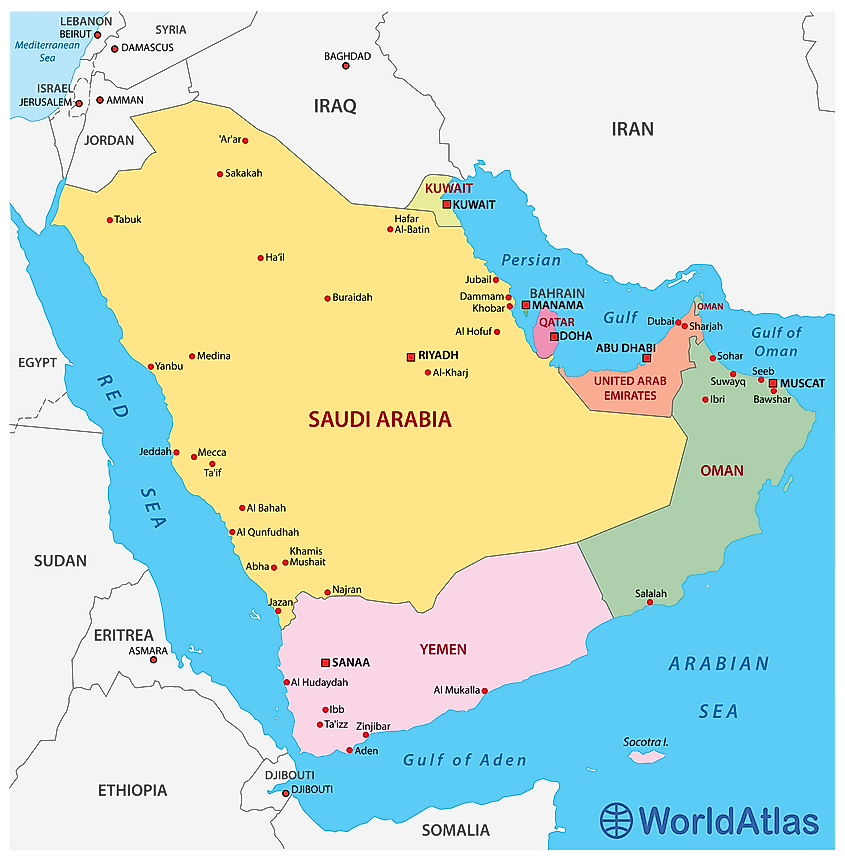
Initially, the Arabian Peninsula was divided into four main regions; Hadhramaut (Indian Ocean Coast), Al-Yamama (Central Plateaus), Al-Bahrain (Persian Gulf Coast), and Tihamah (Red Sea Coast). Today, the peninsula is subdivided into six countries, with two more countries also extending onto the peninsula. The six countries located wholly on the peninsula are Saudi Arabia, Oman, Kuwait, Qatar, Yemen, and the United Arab Emirates (UAE). The southern portion of Jordan and Iraq also extends onto the peninsula. Geopolitically, Bahrain is also part of the peninsula.
The UAE, Qatar, and Kuwait are located on the peninsula’s eastern portion. Oman occupies the southeastern part, while Yemen is in the south. Saudi Arabia is at the center, while Bahrain lies on the peninsula’s east coast. Saudi Arabia is the largest country on the peninsula, occupying 2.15 million square kilometers or 66% of the peninsula’s total area. Yemen is the second-largest country, covering about 16%, while Oman occupies about 9.6%. Qatar is the smallest country on the mainland peninsula, while Bahrain is the smallest country within its geopolitical region.
Origin Of Name
The name “Arabian” is derived from the “Arab” or “Arabs.” The name “Arab” first appeared in the Assyrian text of 853 BC, describing the matu arbai, called Gindibu. The variation of the name “Arab,” including Arubu, Arabi, and Aribi, are mentioned severally until around the 6th century BC. Aribi indicates a form of submission to the Assyrians. Arabia, as a place-name, first appeared in Greek writing. The term was popularized on the peninsula by Herodotus and other Greek and Latin writers.
An account of Arabs is also recorded in chapter 10 of Genesis of the Bible’s Old Testament. Here, the Arabs are referred to as Noah's descendants. His son Shem is considered the ancestor of Arabs, Hebrews, and Arameans. However, the term “Arabs” is not mentioned explicitly in Genesis. Instead, the term “Erev” is used.
During the period between Alexander the Great’s death and the emergence of the Roman Empire (Hellenistic Period), the peninsula and its surroundings were referred to as Aravia or Arabia. Ancient geographers divided the area into three regions; Arabia Felix (present-day Yemen), Arabia Deserta (Desert Arabia), and Arabia Petrea
Important Geographical Features
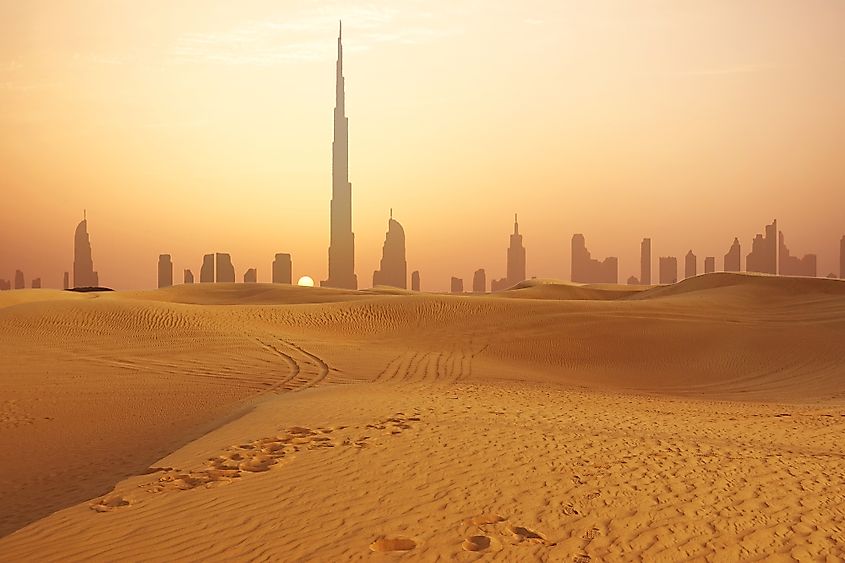
Several geographical features characterize the Arabian Peninsula’s landscape, including plateaus, desert range, mountains, and coastlands. The peninsula is mostly covered by deserts, making it one of the world’s driest regions. The Nafud Desert on the northern part stretches over 103,600 square kilometers and is 290 km long and 225 km wide. This desert is known for sudden violent wind responsible for the crescent-shaped dunes. On the south is the Rub’ al Khali Desert that is part of the Great Arabian Desert. This desert covers 650,000 square kilometers or about one-third of the Arabian Desert and includes parts of Yemen, The UAE, Oman, and Saudi Arabia.
The mountains are found along the peninsula’s northwestern, southern, and eastern borders. The Hajar Mountains are the highest mountain ranges on the east and are shared by Oman and the UAE. The Dhofar Mountains are found on the southeastern side, specifically in Oman. On the west are Hijaz, Asir, and Haraz Mountains. Other mountains on the peninsula include Shammar, Tuwair, and Jabal Hadhur (the peninsula’s highest mountain).

The peninsula is also crossed by a plateau of more than 760 meters above sea level. The central plateau is known for pasture and fertile valleys, making it suitable for livestock grazing. The peninsula has few rivers or lakes, with the area drained by wadis which are dry most of the time. Oases form mainly where there is surface water. Two of the largest oases in the world, Qatif, and Al-Hasa are in Arabia.
Climate
The Arabian Peninsula is characterized by intense temperature, especially during summer, reaching as high as 129 degrees Fahrenheit. Although much of the interior is dry, in the southern highlands and coastal areas the humidity is extreme during the summer months. These humid areas may also receive fogs and dews, which serve as rain.
Rainfall is scarce in areas not reached by the Indian Ocean monsoon. Desert regions receive torrential rains occasionally, causing wadis to flood. However, drought can last several years. The monsoon is responsible for the high precipitation in the south and southwest. The northern parts receive monsoons from the Mediterranean, blowing towards the Persian Gulf and south towards Yemen through Rub al-Khali.
Plants And Animals
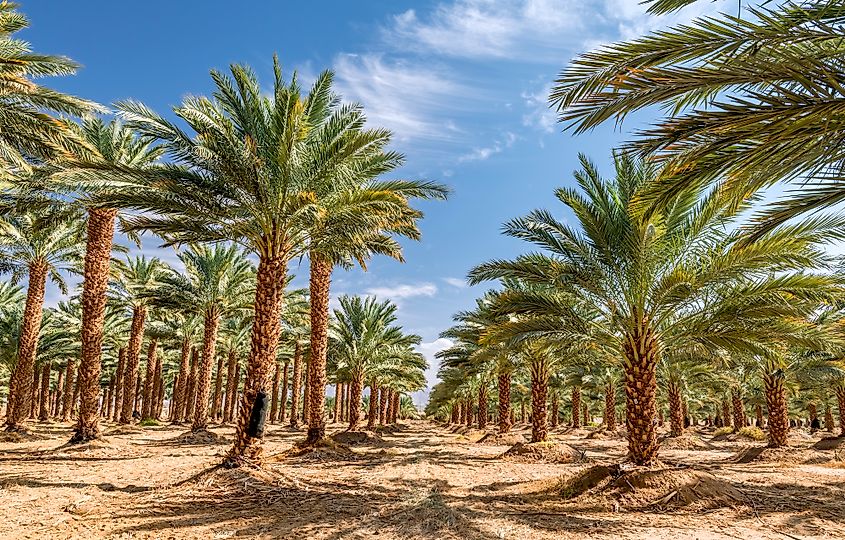
Arabia is often hot and dry almost throughout the year, making it only suitable for desert species. However, date palms are common everywhere, except in Dhofar. Dates are popular sources of food, with areas such as Bishah and Medina known for quality dates. The coastal areas are dotted with coconut palms, while grains such as sorghum, wheat, millet, and barley are also common throughout the peninsula. Besides food plants, other plants that grow on the peninsula are acacia, mimosa, cactus, aloe, oleander, junipers, and tamarisk.
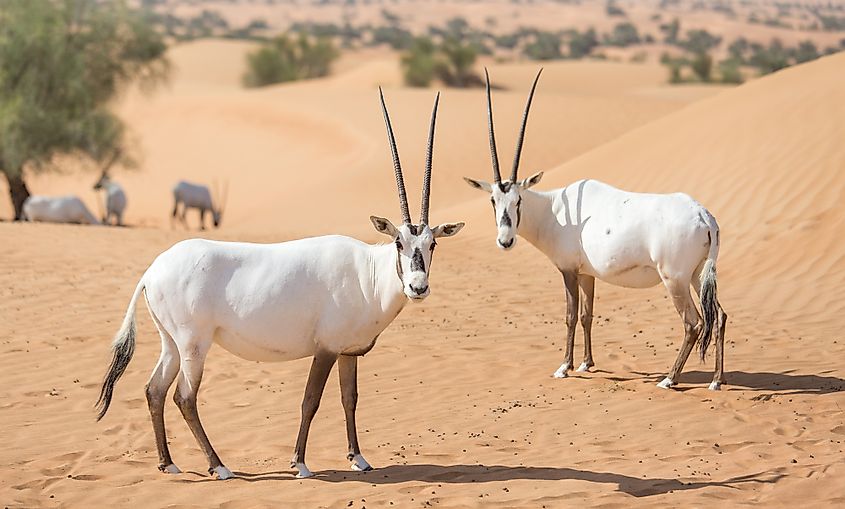
Camels have been the chief animals of the Arabians, especially nomads. They were the main means of transport in the desert and also provided milk, food, and fuel (dung). Apart from camels, there are numerous goats and sheep (collectively known as ghanam) and Arabian horses. Wild animals include gazelles, Oryx, ibex, hyena, jackal, hedgehog, ratel, jerboa, and wolf. Deadly snakes include desert species such as striped sea snakes, horned viper, and cobra. The seas around the peninsula contain several fish species, including tuna, grouper, mackerel, and porgies.
History Of Human Settlement In The Arabian Peninsula

The Arabian Peninsula may have been inhabited as early as 130,000 years ago. But, it is estimated that the first people to settle on the peninsula migrated from Africa about 90,000 years ago. However, the region’s harsh climate discouraged people from building settlements, except for trading settlements in Medina and Mecca.
Pre-Islamic Arabia was characterized by several civilizations, including the Kingdom of Awsan, Himyarite Kingdom, and the Kingdom of Main in South Arabia, and Dilmun Civilization in Eastern Arabia. The rise of Islam on the peninsula began around the 7th century. Prophet Muhammad, Islam founder, was born in Mecca in 570 and began preaching around 610. He migrated to Medina 12 years later and united the Arabian tribes under the Islam banner.
Throughout Arabian history, the arm-bearing tribe dominated other tribes, which included nomadic and oases dwellers. The Sultans and Sheikhs were mainly drawn from tribes that supported arm-bearing tribesmen. However, the descendants of Prophet Mohammad were considered superior to others on the social scale. The pastoral tribe, known as Bedouin, and the settler tribe, or al-hadar also had a longstanding conflict between them.
Important Population Centers
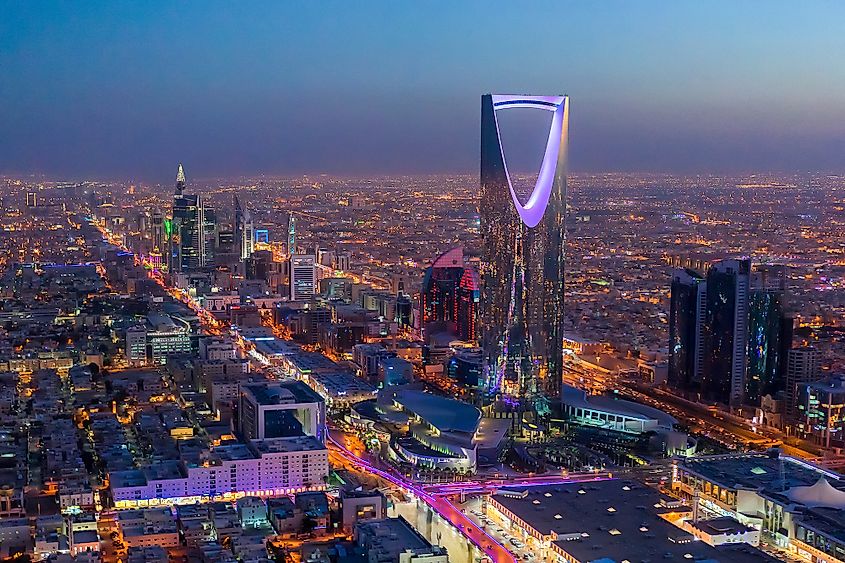
An estimated 86.2 million people live on the Arabian Peninsula. The region's high population is supported by a high immigration rate. It also has one of the most skewed population, with almost all the countries having more men than women. At about 75%, Qatar has the highest proportion of men in the world. Expatriates and immigrates account for a significant proportion of the peninsula’s population. In Qatar and the UAE, over 80% of their populations are expatriates.
|
Rank |
City |
Population |
|---|---|---|
|
1 |
Riyadh |
7,231,447 |
|
2 |
Jeddah |
4,610,176 |
|
3 |
Kuwait City |
3,114,553 |
|
4 |
Sanaa |
2,972,988 |
|
5 |
Dubai |
2,878,344 |
|
6 |
Mecca |
2,042,106 |
|
7 |
Sharjah |
1,684,649 |
|
8 |
Muscat |
1,549,729 |
|
9 |
Medina |
1,488,782 |
|
10 |
Abu Dhabi |
1,482,816 |
Saudi Arabia is the most populous country on the peninsula, with an estimated 33.4 million people, followed by Yemen, with 28.9 million, and the UAE with 9.5 million people. Riyadh, Saudi Arabia’s capital, is the most populous city, with 7.2 million people. With a population of 4.6 million, Jeddah is the second-most populous city. Other important population centers in Saudi Arabia are Mecca (2 million) and Medina (1.5 million). Kuwait City is the third-largest city in the peninsula, with 3.1 million people, while Sanaa, Yemen, has 3 million residents.
Economy

Some of the world’s wealthiest countries by GDP per capita are located on the Arabian Peninsula. For instance, Qatar is the world’s third-richest country after Luxembourg and Singapore, while the UAE is the 6th richest country. The peninsula’s economy is driven by the abundant oil and natural gas reserves. The Arabian Peninsula has the world’s largest oil reserve. It possesses about 17% of the world’s proven oil reserves, with Saudi Arabia as the world’s largest oil producer, accounting for about 15% of the global production. Over 50% of exports coming from the Arabian Peninsula are petroleum products.
Tourism is a major source of income for the peninsula countries. Arabia is a popular cultural and religious destination, attracting millions of people every year. Every year, millions of Muslim faithful take pilgrimage to Mecca, Prophet Muhammad’s birthplace, and Medina, his resting place. Other travel destinations in Arabian Peninsula include Doha, Dubai, Abu Dhabi, and Kuwait City.
For centuries, the oyster beds in the Persian Gulf produced some of the world's best pearls. Pearling was once a profitable economic activity, with Bahrain as the chief producer. Now, Qatar, the UAE, and Saudi Arabia are also participating in pearling. The region also has vibrant construction and service sectors, supported by the rich oil industry











